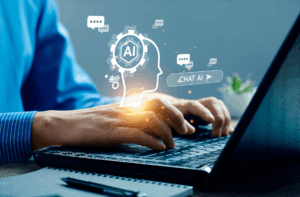 So, What Is Generative AI?
So, What Is Generative AI?
Generative AI (GenAI) is a branch of artificial intelligence that can create new content like text, images, audio, or even video, by learning from existing data. Unlike traditional AI, which only analyzes or predicts outcomes, GenAI can generate original content that feels human-made.
From writing marketing copy and designing graphics to accelerating research and development, GenAI is showing up everywhere. Tools like ChatGPT, Gemini, and DALL·E are just the beginning. But with great innovation comes a not-so-small challenge: how do we protect the data GenAI learns from?
What Do We Mean by Generative AI Security?
Generative AI security is all about protecting the sensitive data that powers these smart systems.
Here’s the issue: GenAI models often need access to huge datasets, some of which might include personal identifiable information (PII), intellectual property (IP), source code, or confidential business materials. If this data isn’t properly secured, it could accidentally be exposed or misused.
And it’s not just about securing access to the GenAI tools themselves; it’s about controlling the flow of data into and out of those tools.
Even with the best intentions, employees may unintentionally paste sensitive content into public GenAI platforms. Once that data is out, there’s no getting it back, and worse, it could be absorbed by the model and potentially surfaced to someone else later.
Effective GenAI security focuses on:
- Encrypting and controlling access to data
- Monitoring what data gets shared or uploaded
- Stopping leaks before they happen, like with DLP
- Meeting compliance requirements like GDPR or CCPA
- Applying persistent protection that follows the data, no matter its location
The goal? Enable innovation without sacrificing privacy or control.
This Isn’t Just One Industry’s Problem. It Affects Every Industry
GenAI is being adopted across industries, and the risks travel with it.
- Law Firms might unknowingly expose sensitive case files when staff use GenAI to summarize documents.
- Marketing Teams could inadvertently leak campaign plans or client data during content brainstorming.
- Manufacturing Companies may lose valuable IP if design files get uploaded to public AI platforms.
- Healthcare Organizations could violate HIPAA regulations if patient info is used without proper controls.
These aren’t hypothetical examples; they’re real-world risks happening today. Every industry that handles sensitive data (and that’s almost all of them) needs to take GenAI security seriously.
Whether you’re in finance, healthcare, legal, manufacturing, or tech, one thing is clear: if you’re using GenAI, you need to secure your data.
How Can You Protect Your Data While Using GenAI?
The best defense? Data-centric security. It works behind the scenes, moving with your data wherever it goes. Secure your data before, during, and after it is used. That’s where Fasoo’s data-centric security comes in. Let’s look at a few options:
One simple approach is to completely block all forms of Generative AI. However, someone can always find a way around it.
The two other ways to protect the data are with either Fasoo Enterprise DRM (FED) or Fasoo AI-Radar DLP (AI-R DLP).
Fasoo Enterprise DRM (FED)
FED protects your files from the moment they’re created. It encrypts documents, applies dynamic access policies, and travels with the file. So, your data stays protected whether it’s stored internally, emailed externally, or copied to the cloud.
With FED, you get:
- Zero Trust, file-based protection
- Granular control (view, edit, print, copy, share)
- Always-on encryption
- Real-time monitoring and audit trails
- Support for CAD, Office files, and more
No matter who has the file or where it ends up, it stays protected. Even if someone downloads or forwards a file, they can’t access it without permission.
Simply put, this is the product you need if you want nothing to be uploaded.
Fasoo AI-Radar DLP (AI-R DLP)
AI-R DLP is specifically designed to prevent sensitive information from being entered into public GenAI tools, by accident or on purpose. It allows the user to still use these tools without risking the data.
Here’s what it does:
- Detects sensitive content using AI and pattern matching
- Blocks uploads to tools like ChatGPT based on preset policies
- Provides an easy-to-use dashboard for setting controls and tracking behavior
Whether it’s PII, source code, or trade secrets, AI-R DLP makes sure it doesn’t end up where it shouldn’t.
Quick Checklist: Is Your GenAI Use Secure?
Before your team interacts with a GenAI tool, ask yourself:
- Are files with sensitive data automatically encrypted?
- Can you control who can view, edit, or share those files?
- Are employees blocked from pasting confidential info into GenAI tools?
- Can you revoke access to shared documents instantly?
- Do you know where your sensitive data is going—and who’s using it?
- Are your security policies consistently applied across cloud and on-prem systems?
- Are you meeting industry regulations and audit requirements?
If you’re unsure about any of these, it might be time to re-evaluate your GenAI data security strategy.
Final Thoughts: Don’t Let Innovation Compromise Security
There’s no question that GenAI is here to stay, and it’s changing the way we work, create, and compete. But without the right protections in place, it can also open the door to serious risks.
Fasoo helps organizations embrace GenAI safely. You don’t have to choose between innovation and security. Whether you’re concerned about insider threats, regulatory compliance, or simply maintaining control over sensitive files, our Enterprise DRM and AI-Radar DLP solutions are designed to keep your data secure—no matter how it’s used.
Learn more about Fasoo’s data-centric security solutions and see how we help organizations unlock the potential of GenAI securely and confidently.

 So, What Is Generative AI?
So, What Is Generative AI?